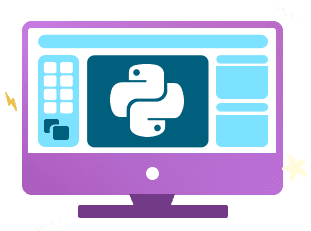While Java and Python have both been around for decades, they’re still the programming languages of choice for many projects. In fact, a prominent source indicates Python and Java have been the second and third most popular languages behind JavaScript for years.
As an aspiring software developer or data scientist, how do you decide which of these popular languages to learn? Since Java and Python both have large communities and a strong future, they’re both great choices for beginning programmers. That said, one language might be more relevant than the other for certain types of tech roles or projects.
In this post, we’ll discuss the ins and outs of Java vs. Python to help you decide which language is right for you. Read on to learn more about the two popular programming languages.
Contents
- 1 TL;DR: Key Differences Between Java vs. Python
- 2 What is Python?
- 3 What is Java?
- 4 Advantages of Python
- 5 Advantages of Java
- 6 Python Disadvantages
- 7 Java Disadvantages
- 8 Which is More Difficult Java or Python?
- 9 Should I Learn Java or Python?
- 10 Kickstart Your Coding Journey With Treehouse
- 11 Land Your Dream Python Developer Job in 2023!
TL;DR: Key Differences Between Java vs. Python
- Python is a dynamically typed, interpreted language built with simplicity in mind
- Java is a statically typed, compiled and interpreted language for portability and speed
- Both Python and Java are used for back-end web development
- Python is more popular for data science use cases
- Java can be used to build Android applications
- Many students find the Python syntax easier to learn than Java
What is Python?
Python is a high-level, general-purpose programming language that was designed with a focus on code readability. The language was first released in 1991 and has since become one of the most popular choices for data scientists and web developers. Python is highly extensible, so there are many libraries available for different use cases that has further fueled the language’s popularity.
The latest version of the language is Python 3, which was a significant revision to the language that isn’t fully backwards compatible with previous versions. While there are ways to convert Python 2 code to Python 3, community support for the older version of Python has since ended. At this point most developers have adopted Python 3, making it the best starting point when learning the language.
As an interpreted language, Python code can be run using the Python Interpreter without the developer needing to compile it beforehand. This approach makes Python very portable because it’s not compiled into machine code that’s tied to a specific platform. There are many other interpreted languages that are popular today, including JavaScript, Ruby, and PHP.
Python is dynamically typed, meaning the interpreter determines the type of variables during runtime. For this reason — and many other design choices by the language creators — Python code is more concise than other languages, which makes it easier to read and understand. Since Python contains less repetitive “boilerplate” code, developers can often build programs faster than more verbose, statically typed languages.
Flexibility is another major distinguishing feature of Python. The language supports object oriented programming, but Python programs can also be developed using functional, procedural, or other programming design paradigms. This gives developers the freedom to structure their Python programs in a way that makes the most sense for a particular use case.
The most common use cases for Python are:
- Data science with machine learning libraries like TensorFlow and PyTorch
- Web development using frameworks like Flask or Django
- Scientific computing with libraries like NumPy, SciPy, and Matplotlib
- Game development with the PyGame library
- Simple scripts for automating repetitive tasks
What is Java?
Java is a general-purpose programming language that was designed for developers to write code once and run it anywhere. The language was first released in 1996 by Sun Microsystems, and has since become one of the most widely used programming languages for enterprise software, Android development, and web development.
The latest official implementation of the language is the Java Standard Edition 18, which is currently owned by Oracle. However, the Java OpenJDK is gaining popularity with the support of Red Hat, Apple, IBM, and other major tech companies. The Android SDK is also built atop Java, but the bytecode it compiles into isn’t compatible with standard Java bytecode.
While many languages are either interpreted at runtime (like Python) or compiled beforehand (like Go), Java is unique in that it’s compiled into bytecode in advance and then interpreted by the Java Virtual Machine (JVM) at runtime. Java bytecode is different from machine code in that it’s not tied to a specific platform. This approach enables Java to balance the speed of compiled languages with the portability of interpreted languages.
Statically typed languages like Java are considered much more verbose, meaning developers need to write more code to meet strict syntax requirements. While this may make certain development tasks take longer, it also has the advantage of preventing many potential issues that would only be discovered at runtime by a dynamically typed or interpreted language.
Although later versions of Java have added some functional programming features to the language, it was very much designed with object oriented programming in mind. This involves structuring Java programs using classes and objects for clarity and reusability. Most development teams find programs that follow object oriented design principles to be easier to maintain as the size of their code base grows.
The most common use cases for Java are:
- Mobile app development with the Android SDK
- Web development using the Spring Framework
- Developing cross-platform desktop GUI applications
- Enterprise applications with the Java Enterprise Edition (Java EE) platform
- Embedded systems development with Java Micro Edition (Java ME) platform
Advantages of Python
We’ve already given a brief overview of Python, but here are some of the key advantages of the language:
- The simplicity of the Python syntax makes it an easier language to learn
- Python allows developers to use a variety of programming styles or paradigms
- Python code can be run on any device that supports the Python Interpreter
- Since Python is an interpreted language, it’s easier and faster to test code changes
- Python code is usually several times shorter than equivalent Java code
Advantages of Java
Next, let’s look at some of the benefits of Java:
- Compiling to bytecode makes Java faster than most interpreted languages
- Java is very portable and can run on any machine that supports the JVM
- Many bugs can be caught when Java code is being compiled
- Large code bases are easier to maintain with Java’s object oriented features
Python Disadvantages
There are a number of advantages to Python, but like any language there are some drawbacks as well:
- Python programs are often slower than compiled languages
- Since Python isn’t compiled, many bugs may not be caught until runtime
- Python isn’t natively supported by the major mobile platforms
Java Disadvantages
Finally, let’s consider a few of the disadvantages to Java:
- Java code is often longer so it’s a bit harder to learn and understand
- Since Java code is more verbose, it often takes longer to write than Python programs
- Java is generally limited to object oriented programming (vs. procedural, functional, etc)
Which is More Difficult Java or Python?
When it comes down to it, there aren’t dramatic differences in the learning curves of any major programming language. That said, many students find the Python syntax easier to pick up because it’s more concise and looks more similar to English than Java. At the same time, the strict rules of Java makes it easier to detect potential issues during development because the IDE can provide more useful syntax highlighting and other tips.
Instead of deciding which language is easier to learn, it makes more sense to think about which language will bring you closer to your future career aspirations. In addition, many experienced developers find themselves learning multiple programming languages throughout their careers, so learning either language will make it much easier to learn another in the future.
Should I Learn Java or Python?
Deciding whether to learn Java or Python depends on your interests and career aspirations in the tech industry. Both languages are used for web development, but they each are more popular for specific use cases.
If you’re interested in data science, Python is definitely a better choice than Java. There’s a lot of data-related libraries for Python, so it’s used by many data professionals on a daily basis for data analysis, data visualization, and AI/ML. Python is also often combined with HTML, CSS, and JavaScript for full-stack web development using frameworks like Flask or Django.
Java is much more common at enterprises and large corporations, so if you’re interested in working on large applications or legacy software, Java is a good choice. In addition, Java (along with Kotlin) is used to develop Android applications. Since Java has so many different use cases, there are a lot of software development, mobile development, and web development jobs to choose from.
Kickstart Your Coding Journey With Treehouse
Choosing which programming language to start with can seem difficult, but deciding the type of tech job you’re interested in can make it much easier. Both languages are good choices for back-end web development, but Python is better for data science and Java makes sense for Android development.
Treehouse offers beginner Tracks for both Python and Java. These courses offer guided curriculums and workshops designed to teach you the basic syntax and core programming concepts of these popular programming languages. In addition, Treehouse offers a Python Development Techdegree that helps you gain the real-world experience you need to become a Python developer.
Land Your Dream Python Developer Job in 2023!
Learn to code with Treehouse Techdegree’s curated curriculum full of real-world projects and alongside incredible student support. Build your portfolio. Get certified. Land your dream job in tech. Sign up for a free, 7-day trial today!
Start a Free Trial







